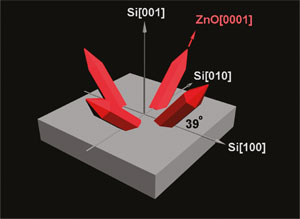Researchers at Missouri University of Science and Technology have developed a method that could be used to make more efficient solar cells by growing and precisely aligning microscopic, spear-shaped zinc-oxide crystals on a surface of single-crystal silicon.
Prof Jay Switzer and his colleagues at Missouri S&T say that their simple, inexpensive process could also lead to new materials for ultraviolet lasers, solid-state lighting and piezoelectric devices.
Switzer's team grew the zinc-oxide nanospears on a single crystal of silicon placed in a beaker filled with an alkaline solution saturated with zinc ions. The process yields tilted, single-crystal, spear-shaped rods about 100-200 nanometres in diameter that grow out of the silicon surface like tiny spikes.
Zinc oxide is a semiconductor that possesses some unusual physical properties, Switzer said. The material both absorbs and emits light, so it could be used in solar cells to absorb sunlight as well as in lasers or solid-state lighting as an emitter of light.
Silicon is also a semiconductor, but it absorbs light at a different part of the spectrum than zinc oxide. By growing zinc oxide on top of the silicon, 'you're putting two semiconductors on top of each other, thereby widening the spectrum from which a solar cell could draw light,' added Switzer.
Previous efforts to grow zinc oxide on silicon have been limited to expensive ultra-high-vacuum methods, and because of silicon's high reactivity, it has been impossible to deposit the zinc oxide directly, without the use of a third material as a buffer. In addition, previous attempts to align the two materials epitaxially have been unsuccessful.
By tilting the nanospears 51°, Switzer and his team have reduced the mismatch from 40 per cent to just 0.2 per cent, a near-perfect alignment, important to ensure higher efficiency.
Switzer's research is supported through a four-year $700,000 (£601,794) grant from the US Department of Energy's Office of Basic Energy Sciences, Materials Sciences and Engineering Division.

These red zinc-oxide 'nanospears' developed by Missouri S&T researchers grow on a surface of silicon. (Illustration provided by Dr Jay A Switzer)




Nanogenerator consumes CO2 to generate electricity
Nice to see my my views being backed up by no less a figure than Sabine Hossenfelder https://youtu.be/QoJzs4fA4fo